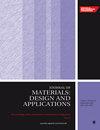Performance of polyvinyl chloride-based E-glass reinforced isophthalic and orthophthalic polyester sandwich composites: A comparative study
IF 2.2
4区 材料科学
Q3 MATERIALS SCIENCE, MULTIDISCIPLINARY
Proceedings of the Institution of Mechanical Engineers, Part L: Journal of Materials: Design and Applications
Pub Date : 2024-07-23
DOI:10.1177/14644207241263743
引用次数: 0
Abstract
This study investigates the performance of sandwich composites composed of polyvinyl chloride cores reinforced with E-glass fibers and bonded with isophthalic and orthophthalic polyester skins. The aim is to comparatively assess the mechanical and morphological characteristics of these composite structures. The comparative analysis also included variations in the skin thickness of the sandwich composite. Mechanical tests such as compressive, impact, and hardness were carried out. Moreover, fracture tests specifically focusing on single-edge notched beam fracture (mode I) were conducted under different temperature conditions, low (−10 °C), ambient (25 °C), and high (100 °C) temperatures. Comparative analysis of the mechanical properties indicated that the isophthalic-based sandwich composites exhibited superior mechanical characteristics when compared to their orthophthalic counterparts. Fracture properties of both types of sandwich composites demonstrated higher values at lower temperatures, followed by room temperature, and then high temperatures. In both types of sandwich composites, using two layers of E-glass on both sides of the polyvinyl chloride foam resulted in superior properties. This improvement can be attributed to the increased skin thickness. The interfacial properties were identified using Fourier transform infrared spectroscopy and scanning electron microscopy, revealing distinct spectroscopic features such as CH-stretching, C–O–C, CH bend, CN stretching, and NH stretching. Examination of the fractured surfaces through scanning electron microscopy revealed distinct features such as crushed fiber, fiber pull-out, honeycomb, riverline patterns, matrix-fiber delamination, and debonding, providing valuable insights into the composite's structural integrity.聚氯乙烯基 E 玻璃增强间苯二甲酸和邻苯二甲酸聚酯夹层复合材料的性能:比较研究
本研究调查了由 E 玻璃纤维增强的聚氯乙烯芯材与间苯二甲酸和邻苯二甲酸聚酯表皮粘合而成的夹层复合材料的性能。目的是比较评估这些复合材料结构的机械和形态特征。比较分析还包括夹层复合材料表皮厚度的变化。进行了压缩、冲击和硬度等机械测试。此外,还在低温(-10 °C)、常温(25 °C)和高温(100 °C)等不同温度条件下进行了断裂测试,重点是单边缺口梁断裂(模式 I)。对机械性能的比较分析表明,与邻苯二甲酸夹层复合材料相比,间苯二甲酸夹层复合材料具有更优越的机械性能。两种夹层复合材料的断裂性能在较低温度下都表现出较高的数值,其次是室温,然后是高温。在这两种夹层复合材料中,在聚氯乙烯泡沫的两侧使用两层 E 玻璃都能获得更好的性能。这种改善可归因于表皮厚度的增加。使用傅立叶变换红外光谱和扫描电子显微镜对界面特性进行了鉴定,发现了明显的光谱特征,如 CH 拉伸、C-O-C、CH 弯曲、CN 拉伸和 NH 拉伸。通过扫描电子显微镜对断裂表面进行检查,发现了破碎纤维、纤维拉出、蜂窝、河纹图案、基体-纤维分层和脱粘等明显特征,为了解复合材料的结构完整性提供了宝贵的信息。
本文章由计算机程序翻译,如有差异,请以英文原文为准。
求助全文
约1分钟内获得全文
求助全文
来源期刊

CiteScore
4.70
自引率
8.30%
发文量
166
审稿时长
3 months
期刊介绍:
The Journal of Materials: Design and Applications covers the usage and design of materials for application in an engineering context. The materials covered include metals, ceramics, and composites, as well as engineering polymers.
"The Journal of Materials Design and Applications is dedicated to publishing papers of the highest quality, in a timely fashion, covering a variety of important areas in materials technology. The Journal''s publishers have a wealth of publishing expertise and ensure that authors are given exemplary service. Every attention is given to publishing the papers as quickly as possible. The Journal has an excellent international reputation, with a corresponding international Editorial Board from a large number of different materials areas and disciplines advising the Editor." Professor Bill Banks - University of Strathclyde, UK
This journal is a member of the Committee on Publication Ethics (COPE).
 求助内容:
求助内容: 应助结果提醒方式:
应助结果提醒方式:


